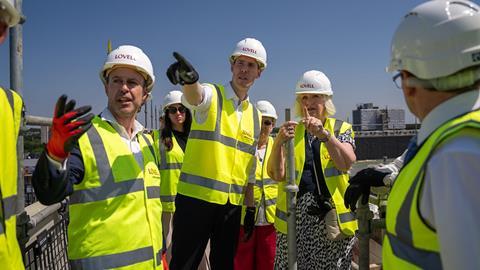Labour shortages pose a huge challenge to the government’s plans for housing and infrastructure. While it is still relatively early days for Keir Starmer and his team, the construction industry is not yet sure whether his party has the answers, writes Daniel Gayne

Amid a flurry of policy launches, scandals and Budget reaction at the end of last year, you could be forgiven for having missed the announcement of the formation of 32 homebuilding skills hubs.
In construction alone, headlines were dominated by the National Planning Policy Framework, where the new government set out the planning policies which will underpin its bold ambition to build 1.5 million homes across the parliament. But, while the skills hubs received relatively little fanfare, the policy is one of a few early clues as to how Labour will approach an issue which will prove pivotal to achieving its more headline-grabbing goals on housing and infrastructure.
Look around and you will see plenty of estimates of how many workers the construction industry needs, when and what for. But, while the experts might haggle over the details, two things are abundantly clear: the number is a big one – and it is much bigger than the number we have got right now.
Workforce demand analysis from the now defunct Infrastructure Projects Authority estimated that, to deliver the £164bn of planned infrastructure investment over the next two years, as many as 360,000 more construction workers will be needed.
According to the Construction Industry Training Board’s (CITB) Construction Skills Network 2024-28 report, 251,500 additional construction workers will be needed over the next four years to meet the anticipated output growth of 2.4% per year.
These high levels of demand are to be placed on an industry with existing shortages, an ageing, shrinking workforce, and a longstanding problem with attracting new talent.
Data from the Employer Skills Survey 2022 showed that, across the economy, the proportion of vacancies in a sector considered to be caused by skills shortage were highest in construction at 52%. Meanwhile, apprenticeship uptake remains stagnant and the CITB reported a net loss of 10,000 workers in 2023 – a 0.9% drop in the overall workforce, which is expected to be followed by a 1.5% drop in 2024 before rates pick up.
The impact of all this is hard to quantify, but again the bottom line is clear: higher labour costs for businesses and delays in the building of the homes and infrastructure which are essential for the country. Last May the House of Commons public accounts committee said that skills shortages were putting at risk plans for major infrastructure delivery.
So, what does Labour plan to do about it? And what do those in the know make of the party’s moves so far?
Almost immediately on taking power, Labour fulfilled its manifesto promise of launching Skills England, a new executive agency which aims to increase flexibility in skills training and cater for specific skills shortages in specific regions. The body, which will replace the Institute for Apprenticeships and Technical Education once the Skills England Bill is passed, already exists as a shadow agency and published its first report last year.
Apprenticeship achievements in Construction, Planning and the Built Environment subjects, England (source: DfE)
| 2018/19 | 2019/20 | 2020/21 | 2021/22 | 2022/23 | 2023/24 | |
|---|---|---|---|---|---|---|
|
Intermediate apprenticeship |
6,616 |
5,548 |
4,989 |
4,406 |
5,156 |
4,848 |
|
Advanced apprenticeship |
3,033 |
2,601 |
2,522 |
2,110 |
2,033 |
1,705 |
|
Higher apprenticeship |
227 |
577 |
870 |
761 |
947 |
1,100 |
|
All apprenticeships |
9,876 |
8,726 |
8,381 |
7,277 |
8,136 |
7,653 |
Under the leadership of former Co-operative boss Richard Pennycook, the body is consulting with employers to provide the Department for Education with views on what priority training should be accessible through the planned growth and skills levy. But, while concept of Skills England has been broadly welcomed across construction, the proof of the pudding will be in the eating.
‚ÄúAs Skills England is still being established, there has been little announcement of the new body‚Äôs strategy or programme of work, so there is little to evaluate at this stage,‚Äù says Niamh Evans, policy and public affairs officer at the Chartered Institute of –«ø’¥´√Ω. She hopes the body will ‚Äúaddress fragmentation of the skills system across different levels of national and local government, and help link the government‚Äôs work across different departments more closely with the needs of industry‚Äù.
Steve Turner, executive director at the Home Builders Federation, similarly says it is “early days” for Skills England and that, while bringing responsibility for skills development into one place could be “a really effective move”, the new body needs to be given enough power and “allowed to set the agenda and lead on policy implementation”.
>> Also read: Skills England proves Labour is serious about its development and growth ambitions
He also speaks warmly of the government’s general approach and engagement with industry on skills, describing it as a “refreshing change of approach from ministers”.
“Early signs are that the government is focused on this as a priority, and the move to devolve money for adult education to combined authorities is a welcome step that has potential to make an impact,” he says.
Shortly after launching Skills England, Keir Starmer and his education secretary, Bridget Phillipson, announced a new growth and skills levy to replace the existing apprenticeship levy. The changes will bring greater flexibility – something which has long been demanded by construction employers – allowing bosses to spend half their levy pot on shorter, modular courses to fill skills gaps identified by industry rather than spending it all on fully fledged apprenticeships.
Then, in mid-December, the government announced further changes to education and training in the built environment, with the Construction T level, first introduced four years ago, scrapped on the basis of low demand.
“In the future, the needs of learners and the economy in this pathway will be met through apprenticeships and other classroom provision,” the government said at the time.

The CIOB’s Evans says that, in light of the defunding of construction T levels and planned reforms to post-16 education, the government needs to “help ensure the national qualification offering ensures there are clear routes for progression into construction careers that are accessible, reputable and appeal to young people”.
Turner at the HBF, meanwhile, stresses the need for further reforms to the levy model. “We require reform of the current model, which sees industry paying two levies – to CITB and the government – such that the process is more flexible and funds can be accessed more easily to deliver training,” he says.
He also says that the CITB itself needs to be “restructured”, noting that some keys skills, such as the installation of heat pumps, currently fall outside its remit.
“Currently less than a third of students on construction courses enter the industry, while we have less than half the number of people holding vocational qualifications compared to our European counterparts. So, quite clearly, urgent change is needed to how we provide construction training in this country,” he adds.
Tessa Hollingworth, managing director of Randstad Construction Property and Engineering, says the government’s levy changes are “a great way to give clients agility to use for upskilling where demand is needed”, but she highlights issues with the curriculum for much of construction training.
We need … more proactive employers going into schools to get the next generation excited about the future of work
Tessa Hollingworth, Randstad
There is “not enough cohesion between the current curriculum and the skills shortages”, she says, citing sustainability skills specifically.
“We need to build a more agile, skill-based curriculum,” she says. “We need to leverage apprenticeships and more proactive employers going into schools to get the next generation excited about the future of work and more focus on us coming together to bridge this issue.”
“I think what Manchester mayor Andy Burnham is doing – going into schools and talking about the skills crisis – is a good example of this.”
Kevin O’Connor, head of social value at Durkan, points out the importance of the government engaging with smaller employers to get a more “rounded view” of the challenges in bringing in new entrants. “It’s important that government understands the realities of risk, cash flow and return on investment for these (often SME) companies when it comes to recruitment and training,” he says.
Professor Andy Westwood, policy director at The Productivity Institute, says sectors like construction and housebuilding need “improved incentives and requirements for building firms and developers to do more training themselves”.
Which brings us onto the latest announcement – 32 homebuilding skills hubs to fast-track training to local areas that need more housing. Announced under the auspices of four different departments (you can see why the creation of Skills England was welcomed by some), the government believes the programme will create 5,000 more construction apprenticeship places per year.
Oversight of the hubs will be split between the Construction Industry Training Board (CITB) and the NHBC. There has been a £140m industry investment in the scheme, £100m of which has come from the NHBC, which will go into its planned network of 12 multi-skills training hubs. These will begin with training in critical areas such as bricklaying, groundwork and site carpentry.
Immersive training meant that we could really accelerate apprenticeship delivery at no loss in quality
Roger Morton, director of business change, NHBC
The NHBC already has four smaller hubs – in Tamworth, Newcastle, Hull and Cambridge – which they say have demonstrated proof of concept.
“Having learnt the lessons there – that immersive training
















